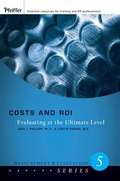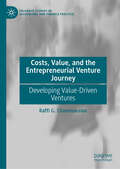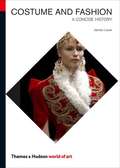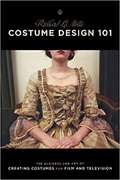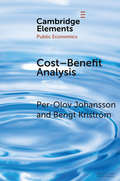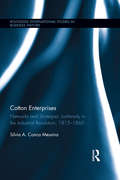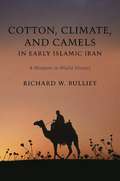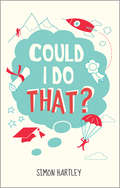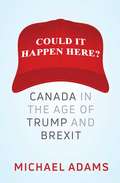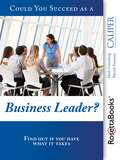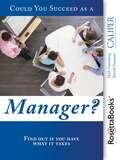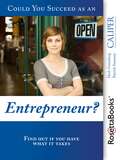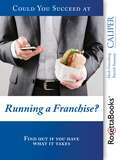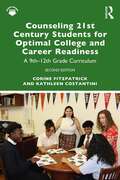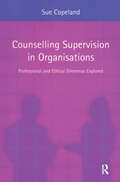- Table View
- List View
Costs and Expenses - No Hard-and-Fast Rules: Financial Intelligence for Entrepreneurs
by Karen Berman Joe KnightMost entrepreneurs watch expenses closely. But did you know that there are plenty of estimates and biases that go into those expense lines? This chapter examines the major line items in this section of the income statement - including cost of goods sold, operating expenses, and one-time charges, among others. This chapter is excerpted from "Financial Intelligence for Entrepreneurs."
Costs and Expenses: No Hard-and-Fast Rules
by John Case Karen Berman Joe KnightMost managers have plenty of personal experience with expenses. But did you know that there are plenty of estimates and biases that go into those expense lines? This chapter examines the major line items in this section of the income statement.
Costs and ROI: Evaluating at the Ultimate Level (Measurement and Evaluation Series #5)
by Jack J. Phillips Lizette ZunigaCosts and ROI Costs and ROI is the fifth of six books in the Measurement and Evaluation Series from Pfeiffer. The proven ROI Methodology--developed by the ROI Institute--provides a practical system for evaluation planning, data collection, data analysis, and reporting. All six books in the series offer the latest tools, most current research, and practical advice for measuring ROI in a variety of settings. All costs must be captured for an accurate cost profile. Costs and ROI focuses on developing program costs and the ROI and explains this vital element in the ROI Methodology. The authors show how to capture all costs in order to bring credibility to the analysis. The book outlines the actual ROI calculation and explains the many assumptions and issues that must be considered when calculating the ROI. Costs and ROI presents three effective calculations: the benefit-cost ratio, the ROI percentage, and the payback period. Costs and ROI includes all the challenges and concerns regarding the use of ROI.
Costs, Value, and the Entrepreneurial Venture Journey: Developing Value-Driven Ventures (Palgrave Studies in Accounting and Finance Practice)
by Raffi G. ChammassianIn the fast-paced world of startups and innovation, costs are often treated with passive recognition—overshadowed by strategy, growth, and funding. But what if costs were the key to unlocking sustainable value and driving strategic success? This groundbreaking book redefines the role of costs within the entrepreneurial venture lifecycles, transforming them from passive considerations to active tools for creating, capturing, and extracting value. Through a fresh lens, it explores the inseparable relationship between costs, strategy, and investments—guiding entrepreneurs, founders, and innovation ecosystem players through every stage of the journey, from ideation to successful exit into a reincarnated life. Finally, it establishes a framework for value-driven business models as dynamic, three-dimensional platforms—driven by technology, markets, and exits—where intellectual capital development plays a fundamental role. With practical insights grounded primarily in strategic management accounting and entrepreneurial finance, and supported by real-world applications, this book establishes a powerful foundation for integrating costs into value-driven business strategies. It equips startup founders, innovation ecosystem players, researchers, and academics alike with the tools to rethink costs as a strategic advantage. Whether you're building a startup, thriving in the innovation and knowledge economy, or delving into entrepreneurial finance, this book will transform the way you think about costs—turning them into a powerful catalyst for growth and success.
Costume And Fashion: A Concise History
by James Laver Amy de la HayeThe new fifth edition of this classic guide to clothing throughout history now extends into the second decade of the 21st century. James Laver's classic study of clothing, from the invention of the needle to the dawn of denim, neolithic weavers to catwalk creations, has been updated once again to cover the latest trends, from vintage to high street chic and the spectacular reinvention of haute couture. Featuring designers such as Alexander McQueen and Marc Jacobs, and style leaders Kate Moss and the Duchess of Cambridge, a new final chapter explains the forces shaping fashion today, including Internet technology, celebrity influence, 'fast fashion', the recession and global markets. With eight new pages, six new illustrations and an entirely new final chapter, this book reclaims its position as the definitive concise history of the subject, and remains essential reading for all students of art, costume and fashion.
Costume Design 101: The Business and Art of Creating Costumes for Film and Television
by Richard LaMotteWritten by an industry venteran with 40 years of experience, this book is the new edition of Costume Design
Cost–Benefit Analysis (Elements in Public Economics)
by Per-Olov Johansson Bengt KriströmThis Element on cost-benefit analysis provides a summary of recent theoretical and empirical developments and summarizes state-of-the-art stated-preference and revealed-preference valuation methods. The Element discusses how to assess small (or marginal) as well as large (or non-marginal) projects that have a significant impact on prices and/or other economic variables. It also discusses distortions like taxes, market power, and sticky prices. In addition, risk/uncertainty is considered. A novel feature is the elaboration on flexible evaluation rules for reasonably small projects. Conventional point-estimates of projects should be used with care, because they typically give biased results.
Cotopaxi: Managing Growth for Good
by Laura Huang Andy WuCotopaxi, an innovative outdoor gear business targeting millennials, focuses on profit and social impact. This registered benefit corporation was formed by Davis Smith who coalesced his experiences as a Wharton MBA student along with professional knowledge from an unpaid internship in Peru and his previous e-commerce startups in the US and Brazil. Cotopaxi's social cause is fighting global poverty; their target is to donate 10% of their profits but as a new capital-intensive business they give 2% of their revenue. Their income streams are mainly direct to consumer sales along with corporate sales and a special experience based event-Questival. Their direct to consumer model lowers costs compared to competitors and allows Cotopaxi to offer lower prices, but they face a challenge in positioning their products as high quality.
Cotopaxi: Managing Growth for Good
by Laura Huang Andy WuCotopaxi, an innovative outdoor gear business targeting millennials, focuses on profit and social impact. This registered benefit corporation was formed by Davis Smith who coalesced his experiences as a Wharton MBA student along with professional knowledge from an unpaid internship in Peru and his previous e-commerce startups in the US and Brazil. Cotopaxi's social cause is fighting global poverty; their target is to donate 10% of their profits but as a new capital-intensive business they give 2% of their revenue. Their income streams are mainly direct to consumer sales along with corporate sales and a special experience based event-Questival. Their direct to consumer model lowers costs compared to competitors and allows Cotopaxi to offer lower prices, but they face a challenge in positioning their products as high quality.
Cottle-Taylor: Expanding the Oral Care Group in India
by John A. Quelch Alisa ZaloshBrinda Patel, director of oral care products for the India division of a consumer home-care product company, develops a data-driven marketing plan for toothbrushes. She believes her plan can support a 20% increase in unit sales based on rising demand for modern oral-care products in India. Her boss, the VP of Marketing, believes her forecast is too conservative and suggests spending more money on promotions to boost sales by 30%. Patel must develop a new plan to meet this higher growth rate by increasing the advertising budget and revising the distribution of the budget across three targeted advertising messages. She must also consider the regional challenges within India between rural and urban consumers and their willingness to adopt a modern approach to dental care. Students must build a projected income statement and consider the effects of increasing the advertising budget and changing the product mix in favor of higher margin toothbrushes.
Cotton Enterprises: Lombardy in the Industrial Revolution, 1815-1860 (Routledge International Studies in Business History)
by Silvia A. Conca MessinaBased on innovative and unique primary sources (e.g. notarial deeds) Cotton Enterprises: Networks and Strategies looks to tell the story of the Lombardy cotton industry in the early 19th century, particularly the stories of entrepreneurs such as Francesco Turati who were able to ‘corner’ this otherwise atomistic industry. The book looks at both the financial and strategic elements of the businesses, as well as looking at enabling technology and even the emergence of factory organization in Italy and takes a business history analysis of pre-industrial business enterprises in a developing economy by taking into account all the crucial functions of enterprise. Cotton Enterprises: Networks and Strategies makes important contributions to the study and research of the financing of early cotton mills, technology transfer in these entrepreneurial ventures, the organization of production, including a detailed discussion of the available technology, networks and relationships within the district. By highlighting the shift from putting-out to factory system, the crucial change of actors (both entrepreneurs and workers) and the birth of a local industrial district, exerting a long-lasting influence on the history of the area the book outlines the building of entrepreneurial networks and social hierarchies in (at the time) a new urban context. Aimed at scholars, researchers and students in the fields of management history, development entrepreneurship and regional economics, Cotton Enterprises: Networks and Strategies answers previously non-addressable questions via innovative research methods and, as such, will be a key work in the field for years to come.
Cotton Sector Development in Ethiopia: Challenges and Opportunities (Textile Science and Clothing Technology)
by Abera Kechi Kabish K. Murugesh Babu Getnet Belay Tesema Bizuayehu Kerisew SemahagnThis book highlights the development of cotton sector and its related issues, in Ethiopia. The book is a comprehensive collection of detailed chapters ranging from agricultural aspects of cotton, its value chain, and economics. It provides an overview of the cotton sector development and the challenges faced in the growth and extension of cotton production and research in three separate sections i.e., cotton agriculture, cotton fibre technology and cross-cutting issues in the cotton sector. In the first part of the book, agricultural aspects of cotton fibre production such as, cotton agronomy, genetics and breeding, biotechnology, mechanized production, crop harvesting management are discussed in detail. This is followed by chapters concerned to a comprehensive knowledge on cotton fibre demand and supply in Ethiopia, ginning technology and industries, cotton quality testing and grading, quality requirements for spinning, cotton fabric production, chemical processing aspects and therole of cotton fabrics in the Ethiopian fashion industry. The final section of the book deals with chapters on the cotton seed production techniques, cotton research and promotion, challenges in quality cotton production, cotton value chain and economics and sustainable cotton production. This book is a valuable resource for all those concerned with cotton biology and agriculture, production and extension, research and development, fashion industry, research and academia.
Cotton, Climate, and Camels in Early Islamic Iran: A Moment in World History
by Richard W. BullietA boom in the production and export of cotton made Iran the richest region of the Islamic caliphate in the ninth and tenth centuries. Yet in the eleventh century, Iran's impressive agricultural economy entered a steep decline, bringing the country's primacy to an end. Richard W. Bulliet advances several provocative theses to explain these hitherto unrecognized historical events. According to Bulliet, the boom in cotton production directly paralleled the spread of Islam, and Iran's agricultural decline stemmed from a significant cooling of the climate that lasted for over a century. The latter phenomenon also prompted Turkish nomadic tribes to enter Iran for the first time, establishing a political dominance that would last for centuries. Substantiating his argument with innovative quantitative research and recent scientific discoveries, Bulliet first establishes the relationship between Iran's cotton industry and Islam and then outlines the evidence for what he terms the "Big Chill." Turning to the story of the Turks, he focuses on the lucrative but temperature-sensitive industry of cross-breeding one-humped and two-humped camels. He concludes that this unusual concatenation of events had a profound and long-lasting impact not just on the history of Iran but on the development of world affairs in general.
Cotton, Water, Salts and Soums: Economic and Ecological Restructuring in Khorezm, Uzbekistan
by Inna Rudenko P.L.G. Vlek John P.A. Lamers Christopher MartiusThis book summarizes a long-term research project addressing land and water use in the irrigated areas of the Aral Sea basin. In an interdisciplinary approach, natural and human sciences are combined to elucidate the challenges of economic transition that affect the use of land, water and biological resources, ecological sustainability, economic efficiency and the livelihoods of the local population. The research focuses on Khorezm, a region in Uzbekistan, located on the Amudarya river, in the heart of Central Asia. A series of chapters describes the biophysical environment and the aspects of society and institutions that shape land and water use. The book discusses options and tools to improve land and water management, and to reform the economic system management, based on agronomic, hydrological, economic ans social studies and modeling. The insights are not only important for Uzbekistan, but for all countries in transitions and irrigated dryland areas elsewhere.
Cougars
by Mihir A. Desai Scott P. MasonProvides an introduction to zero coupon bonds and stripping coupon bonds. Concerns the relationship between the spot curve, the strip curve, and the coupon curve.
Could I Do That
by Simon HartleyYes you can!Hands up who feels like a completely inadequate underachiever whenever you hear about someone's great achievement. When someone in the office is off cycling around the world, or someone on TV has just launched a great new business which will save the planet? Most of us envy the drive and determination of these people. They've actually made this stuff happen rather than just day-dreamed about it. We all ask...Could I Do That?Well Simon Hartley is here to show us that we can! Taking on a challenge - big or small - in your career or personal life, can be intimidating but also totally transformational. Simon will show us how to work out what it is we want to do and then how to make that happen. He uses examples and advice from others who have achieved big things.The book examines how you should go about preparing for change, which problems you'll face along the way, and demonstrates why and how your life will be better as a consequence.Practical and motivational, it's about embracing change and defeating limiting beliefsIt challenges readers to think big and take steps to achieving their goalsIt puts power in the hands of people who don't yet realise that they can do extraordinary things too
Could It Happen Here?: Canada in the Age of Trump and Brexit
by Michael AdamsFrom award-winning author Michael Adams, Could It Happen Here? draws on groundbreaking new social research to show whether Canadian society is at risk of the populist forces afflicting other parts of the world.Americans elected Donald Trump. Britons opted to leave the European Union. Far-right, populist politicians channeling anger at out-of-touch “elites” are gaining ground across Europe. In vote after shocking vote, citizens of Western democracies have pushed their anger to the top of their governments’ political agendas. The votes have varied in their particulars, but their unifying feature has been rejection of moderation, incrementalism, and the status quo. Amid this roiling international scene, Canada appears placid, at least on the surface. As other societies retrench, the international media have taken notice of Canada’s welcome of Syrian refugees, its half-female federal cabinet, and its acceptance of climate science and mixed efforts to limit its emissions. After a year in power, the centrist federal government continues to enjoy majority approval, suggesting an electorate not as bitterly split as the ones to the south or in Europe. As sceptics point out, however, Brexit and a Trump presidency were unthinkable until they happened. Could it be that Canada is not immune to the same forces of populism, social fracture, and backlash that have afflicted other parts of the world? Our largest and most cosmopolitan city elected Rob Ford. Conservative Party leadership hopeful Kellie Leitch proposes a Canadian values test for immigrants and has called the Trump victory “exciting.” Anti-tax demonstrators in Alberta chanted “lock her up” in reference to Premier Rachel Notley, an elected leader accused of no wrongdoing, only policy positions the protesters disliked. Pollster and social values researcher Michael Adams takes Canadians into the examining room to see whether we are at risk of coming down with the malaise affecting other Western democracies. Drawing on major social values surveys of Canadians and Americans in 2016—as well as decades of tracking data in both countries—Adams examines our economy, institutions, and demographics to answer the question: could it happen here?
Could You Succeed as a Business Leader?
by Patrick Sweeney Herb GreenbergHave you ever thought about moving from an individual contributor role or management role into a business leadership role? Maybe it sounds like fun, but are you ready to take the plunge? Find out in this fun yet informative ebook that explores the ups and downs of business management. It also includes a short personality quiz to see if you have what it takes. ABOUT THE AUTHORS Herb Greenberg, Ph.D., is the Founder & Chief Executive Officer, and Patrick Sweeney is the President of Caliper, an international management consulting firm, which, for over a half-century, has assessed the potential of more than three million applicants and employees for over 25,000 companies around the world. Headquartered in Princeton, with a dozen offices worldwide, Caliper consults with executives from Johnson & Johnson, Avis, and some of the fastest growing smaller companies around the world on unlocking the potential in individuals, leaders, and teams. The authors have spoken at scores of international conferences and written for The New York Times and the Harvard Business Review. In addition, Herb and Patrick are the authors of the New York Times best seller Succeed on Your Own Terms, as well as How to Hire and Develop Your Next Top Performer, both published by McGraw-Hill. ABOUT THE SERIES When you think about all the career possibilities, it can be overwhelming. So often we hear the terms "manager," "leader," and "entrepreneur," but what do those people really do? And could you do it too? This series of ebooks by Caliper's Herb Greenberg and Patrick Sweeney explores that question as it relates to each of us, and gives us an answer to the question, "Could you succeed as...?" Each ebook talks about the personality traits needed to succeed in that role and how to determine if you have those traits. The authors also spoke extensively with those who have succeeded in the position--and those who failed. What separates the two? These ebooks get to the heart of the issue.
Could You Succeed as a Manager?
by Patrick Sweeney Herb GreenbergHave you ever thought about moving from an individual contributor role into management? Maybe it sounds like fun, but are you ready to take the plunge? Find out in this fun yet informative ebook that explores the ups and downs of business management. It also includes a short personality quiz to see if you have what it takes. ABOUT THE AUTHORS Herb Greenberg, Ph.D., is the Founder & Chief Executive Officer, and Patrick Sweeney is the President of Caliper, an international management consulting firm, which, for over a half-century, has assessed the potential of more than three million applicants and employees for over 25,000 companies around the world. Headquartered in Princeton, with a dozen offices worldwide, Caliper consults with executives from Johnson & Johnson, Avis, and some of the fastest growing smaller companies around the world on unlocking the potential in individuals, leaders, and teams. The authors have spoken at scores of international conferences and written for The New York Times and the Harvard Business Review. In addition, Herb and Patrick are the authors of the New York Times best seller Succeed on Your Own Terms, as well as How to Hire and Develop Your Next Top Performer, both published by McGraw-Hill. ABOUT THE SERIES When you think about all the career possibilities, it can be overwhelming. So often we hear the terms "manager," "leader," and "entrepreneur," but what do those people really do? And could you do it too? This series of ebooks by Caliper's Herb Greenberg and Patrick Sweeney explores that question as it relates to each of us, and gives us an answer to the question, "Could you succeed as...?" Each ebook talks about the personality traits needed to succeed in that role and how to determine if you have those traits. The authors also spoke extensively with those who have succeeded in the position--and those who failed. What separates the two? These ebooks get to the heart of the issue.
Could You Succeed as an Entrepreneur?
by Patrick Sweeney Herb GreenbergHave you ever thought about owning your own business and being your own boss? Maybe it sounds like fun, but are you ready to take the plunge? Find out in this fun yet informative ebook that explores the ups and downs of business management. It also includes a short personality quiz to see if you have what it takes. ABOUT THE AUTHORS Herb Greenberg, Ph.D., is the Founder & Chief Executive Officer, and Patrick Sweeney is President of Caliper, an international management consulting firm, which, for over a half-century, has assessed the potential of more than three million applicants and employees for over 25,000 companies around the world. Headquartered in Princeton, with a dozen offices worldwide, Caliper consults with executives from Johnson & Johnson, Avis, and some of the fastest growing smaller companies around the world on unlocking the potential in individuals, leaders, and teams. The authors have spoken at scores of international conferences and written for The New York Times and the Harvard Business Review. In addition, Herb and Patrick are the authors of the New York Times best seller Succeed on Your Own Terms, as well as How to Hire and Develop Your Next Top Performer, both published by McGraw-Hill. ABOUT THE SERIES When you think about all the career possibilities, it can be overwhelming. So often we hear the terms "manager," "leader," and "entrepreneur," but what do those people really do? And could you do it too? This series of ebooks by Caliper's Herb Greenberg and Patrick Sweeney explores that question as it relates to each of us, and gives us an answer to the question, "Could you succeed as...?" Each ebook talks about the personality traits needed to succeed in that role and how to determine if you have those traits. The authors also spoke extensively with those who have succeeded in the position--and those who failed. What separates the two? These ebooks get to the heart of the issue.
Could You Succeed at Running a Franchise?
by Patrick Sweeney Herb GreenbergHave you ever thought about owning your own franchise and being your own boss? Maybe it sounds like fun, but are you ready to take the plunge? Find out in this fun yet informative ebook that explores the ups and downs of franchise ownership. It also includes a short personality quiz to see if you have what it takes. ABOUT THE AUTHORS Herb Greenberg, Ph.D., is the Founder & Chief Executive Officer, and Patrick Sweeney is the President of Caliper, an international management consulting firm, which, for over a half-century, has assessed the potential of more than three million applicants and employees for over 25,000 companies around the world. Headquartered in Princeton, with a dozen offices worldwide, Caliper consults with executives from Johnson & Johnson, Avis, and some of the fastest growing smaller companies around the world on unlocking the potential in individuals, leaders, and teams. The authors have spoken at scores of international conferences and written for The New York Times and the Harvard Business Review. In addition, Herb and Patrick are the authors of the New York Times best seller Succeed on Your Own Terms, as well as How to Hire and Develop Your Next Top Performer, both published by McGraw-Hill. ABOUT THE SERIES When you think about all the career possibilities, it can be overwhelming. So often we hear the terms "manager," "leader," and "entrepreneur," but what do those people really do? And could you do it too? This series of ebooks by Caliper's Herb Greenberg and Patrick Sweeney explores that question as it relates to each of us, and gives us an answer to the question, "Could you succeed as...?" Each ebook talks about the personality traits needed to succeed in that role and how to determine if you have those traits. The authors also spoke extensively with those who have succeeded in the position--and those who failed. What separates the two? These ebooks get to the heart of the issue.
Council Tax Handbook
by Tim Smith Geoff ParsonsEG Council Tax Handbook is a timely publication. The text is easy to understand and very comprehensive. This volume helps to define the council tax in various contexts.
Counseling 21st Century Students for Optimal College and Career Readiness: A 9th–12th Grade Curriculum
by Corine Fitzpatrick Kathleen CostantiniThis second edition presents an updated action-based curriculum for high school counselors that will meet the needs of 21st century students, helping to foster their growth and engage them in learning what they need to succeed beyond high school. This book takes a comprehensive, developmental approach, focusing on 9th-12th grade students rather than solely on those in 11th and 12th grade. It provides a model for developing and enhancing a successful college advising office as well as essential advice on methods of working with parents. Specific topics discussed include successful transition to 9th grade, using technology in the college and career advising process, assisting and advising students in college research and application, and helping seniors make successful transitions to college. There is also a special focus on students in urban and rural schools to enable them to have the same enriched experiences in their college and career advising program as those students in private and suburban schools. The curriculum is geared for use by school counselors, college advisors, and readers in graduate counseling student courses.
Counselling Supervision in Organisations: Professional and Ethical Dilemmas Explored
by Sue CopelandCounselling supervision is an expanding area, as increasing numbers of counsellors enter the profession and require supervision on a regular basis. Counselling Supervision in Organisations seeks to provide a model of counselling supervision within organisations, enabling supervisors, counsellors and their line managers to work effectively within organisational cultures for the benefit of all parties in the working alliance. Drawing on her own research, Sue Copeland explores both counselling and supervision cultures and their fit with various organisational cultures. The dilemmas that often arise from a clash between differing cultural norms are discussed in relation to the supervisory process. From securing a supervisory position, contracting for the work, reporting back to the organisation, assessing the work and ending the relationship, through to an in-depth consideration of the supervisory work embedded in a good working relationship, her model provides a blueprint for the supervisory process. The model described in Counselling Supervision in Organisations brings together the cultures of counselling and supervision and their relation to organisational cultures. It will provide a unique resource for counsellors, trainee and professional counselling supervisors and their line managers.
Counsellor Competencies: Developing Counselling Skills for Education, Career and Occupation
by Bernd-Joachim Ertelt William E. Schulz Andreas FreyCareer and student counselling is a complex task that requires a high level of professionalism. This book introduces basic counselling skills in vocational and educational guidance. It is based on important scientific models. The book presents internationally recognized counselling approaches which include among others micro counselling, solution focused brief counselling and competence oriented counselling. It also addresses possibilities for the use of artificial intelligence. The book offers direct guidance for the consulting practice and supports competence development through case studies, tasks and didactically designed exercises. It is suitable as a guide for the training of consulting professionals in the field of career guidance.

